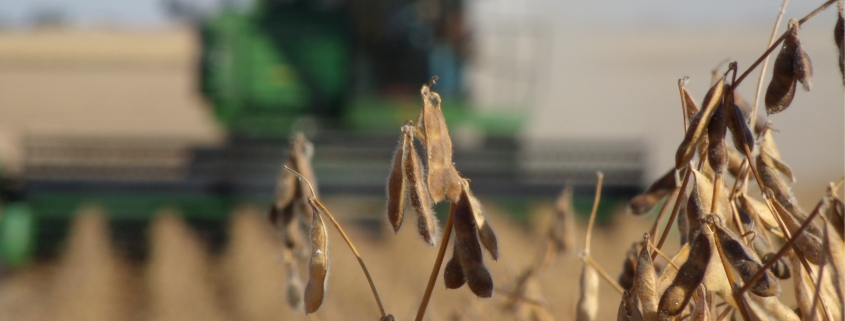IP Crop Network, November Report
This monthly feature from SSGA’s Agronomy Action Team highlights growing conditions for Identity Preserved crops from different regions around the country. Thanks to the states/regions that contributed this month. If you would like to contribute, please get in touch with David Kee or Shane Frederick. You can also follow David Kee on Twitter for some of the latest, most-interesting information on agronomy and research that affect IP and other farmers.
Illinois
If the rains hold off until Wednesday night, as predicted, there will be very little crop left in the field in Illinois. The guess is completion at 95%-plus by mid -week. Last week’s freeze finally finished off the green in the soybeans, especially the double crop, and they started running through the combine pretty well.
Yields in the North and Central areas will end up pretty close to expectations, and the southern part of the state will beat expectations, but likely not enough acres and bushels in the southern third to move the needle on state average.
There is a lot of tillage being done and some fall fertilizer is being applied. Wheat planting is pretty well done in the state, with about half of the crop looking really good – 25% emerging slow and uneven and the last 25% still trying to emerge.
Michigan
The Michigan soybean crop is mostly in the bins. Harvest started earlier than normal in mid-September but was slowed by extended periods of significant rain. Much of the month of October saw limited soybean harvest as farmers switched to harvesting corn in wet fields. Field conditions have improved in November, allowing significant soybean harvest with grain moisture back to acceptable levels. November weather is not always conducive to soybean harvest in Michigan, so this opportunity is a welcome pleasant surprise.
Soybean yields are mostly good throughout the state. The NASS estimated average yield of 50 bushels per acre should be close to actual yields.
Minnesota
Recent rains have alleviated the 2021 drought. Minnesota is still dry, but recent rains continue to ease drought stress. According to the drought monitor, the northern third of the state is rated moderate to extreme drought (D1-D3). Areas in the southeast third of the state are rated abnormally dry to moderate (D0-D1). The southwest quarter drought-free. The Nov. 1 USDA Crop Progress report topsoil moisture supply rated 80% adequate to surplus.
Crop harvest is near completion in Minnesota. Corn silage, small grains and edible beans have been largely harvested. Soybean, sunflower and sugar beet harvests are near completion with variable yields reported. Corn grain harvest is proceeding rapidly with 83% harvested by the end of October. Grain moisture has been sufficiently low that grain drying is limited in scope. Soybean harvest was slowed due to excessive green stems and morning dews reducing harvest speeds. Some farmers are concerned about future crop volunteer issues in 2022 due to excessive harvest escapes. Farmer yield reports in this region vary from “drought impacted” to “well above expectations!”
Field work, soil sampling, tillage, manure and fertilizer applications, etc., continues. Soil temperatures are adequate for fall N fertilizer applications, and P and K containing fertilizers are going down. Farmers appear to be applying fertilizer products previously purchased in the summer. There is a great concern expressed as to input availability in the spring and input price uncertainty.
Missouri
October proved to be another warm month for Missouri with the average temperature being 60.6°F, which was 3.6°F over the long-term average. It was the warmest October since 2016, and it was the third consecutive month with above average temperatures. Most years Missouri experiences its first freeze during October, but only a few locations in northwestern Missouri dipped below freezing during October. For the past 20 years, fall freezes have been trending later.
The statewide average for rainfall was 6.11 inches, which is 2.92 inches above the long-term, which made October 2021 the fifth-consecutive October with wetter conditions than normal. One unusual weather occurrence did happen on Oct. 24, a fall tornado outbreak, with 15 tornadoes being reported.
According to the USDA Crop Progress report, Corn harvest was tabulated at 86% completed on Oct. 31. Soybean harvest was only 59% completed at the same time. Cotton harvest was delayed due to the rainy conditions, so only 59% of the crop had been harvested by Oct. 31, with 71% of crop being in “good” condition. As of Oct. 31, only 63% of the winter wheat was planted, which is 5% more than the five-year average. An estimated 45% of the winter wheat planted has emerged to give a 57% good condition for the winter wheat.
November is looking promising for further increase in crop harvest. Hopefully, we will have completed crop harvests in November.
North Dakota
There are a couple of fields of corn left, but in all practical sense, harvest is complete. Due to the drought, yields are down and most grain is either sold or binned with very little grain on the ground compared to years with large yields.
There is more fall tillage than expected with the dry conditions, but with the early harvest it became too tempting. Even with the high fertilizer prices some fall fertilizer is being applied. Some economists are encouraging the purchase of fertilizer to protect from spring shortages. Most fertilizer dealers are not pre-booking fertilizer.
There have been some rains but not enough to recharge the groundwater. Rain is predicted at the end of the week but changing to snow.







Leave a Reply
Want to join the discussion?Feel free to contribute!